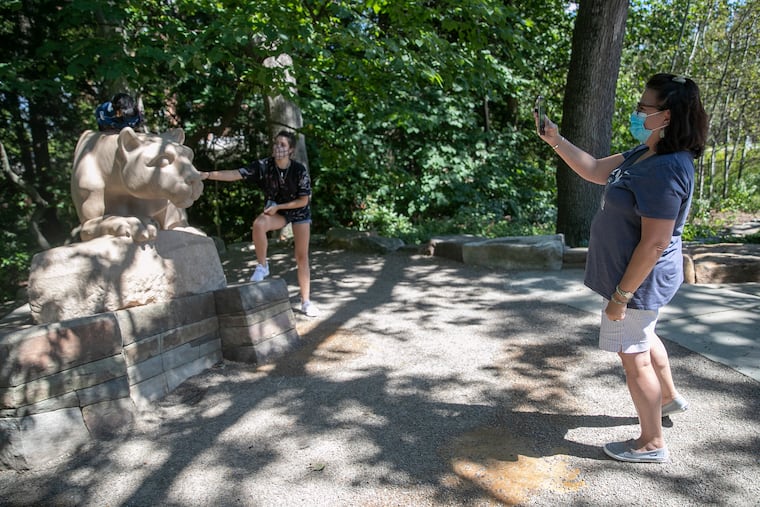With young adults fueling COVID-19, a surge in vulnerable older people may be just weeks away, says CDC
Socializing is a key part of college life — and a key part of COVID-19 transmission dynamics.

As coronavirus cases mount in Pennsylvania and New Jersey, fueled largely by young adults, a federal study of transmission dynamics suggests those youthful infections could drive a surge among vulnerable older adults in less than a month.
On Friday, Pennsylvania reported 1,380 additional positive cases of COVID-19, and New Jersey reported 881 more cases. Both states have said the infection rate is rising fastest among college-age adults.
Whether this is the start of a new wave of infections that will reach the devastating levels of the spring remains to be seen. But as businesses reopen and isolation-weary people eagerly resume some regular activities, more of them — particularly young people — are relaxing precautionary measures.
Across the country, transmission hot spots are being linked to that age group, which includes returning college students.
For example, Penn State University’s main campus in University Park has been driving a spike in cases in Centre County. On Friday, the Pennsylvania Department of Health reported that the proportion of diagnostic tests over the last seven days that came back positive in Centre was 9.4%, the highest positivity rate of any county in the state. Health officials generally consider a 5% positivity rate cause for concern that there is significant COVID-19 spread in the community.
» READ MORE: Hospital coronavirus treatment has changed. Here’s what it looks like now in Philadelphia.
Penn State’s main campus normally has an enrollment of 46,810, but many students are now studying remotely. The campus has seen 2,682 cases, the eighth-most on a college campus in the nation, according to a New York Times survey updated Thursday.
As a percentage of enrollment, however, Penn State’s positivity rate is far better than some other U.S. schools with high case numbers. About 6% of Penn State’s student body has tested positive, compared with 15% at Clemson, 10% at the University of Georgia, and 7% at the University of Wisconsin-Madison, using the Times data and enrollment figures from stateuniversity.com.
Other Pennsylvania schools have even lower numbers. Temple University has reported 528 cases, according to the Times, for a positivity rate of 1.3%. Villanova has seen 193 cases, for a rate of 2.8%.
» READ MORE: Bridging the digital divide for the ‘have’ and ‘have nots’: How schools are meeting the need during remote learning
In New Jersey, Gloucester County added 147 cases to the borough of Glassboro’s totals over the last three days. That’s because the county, following state guidelines, reassigned positive Rowan University students who were listed in their home municipalities to Glassboro, home to Rowan’s campus of 4,100 students.
Rowan’s website says it has had 500 cases among students and employees so far since classes began Sept. 1. In the borough, 89% of the new cases this month are in patients between the ages of 18 and 22, who are far less likely than older adults to suffer the worst effects of the disease. Still, serious illness has been recorded in younger people with no underlying conditions.
Nationally, more than 1,700 American colleges and universities have had more than 178,000 cases and at least 70 deaths since the pandemic began, the Times survey found.
“There is an urgent need to address transmission among young adult populations, especially given recent increases” in cases in this age group, the U.S. Centers for Disease Control and Prevention wrote in Friday’s edition of MMWR.
CDC researchers analyzed data from June and July to identify 767 “hot spot” counties — places where positivity rates were rapidly rising — and then looked at the rates by age group. The analysis found that early increases in positivity rates among people age 17 to 24 were followed by several weeks of rising positivity rates in people 25 and older. Senior citizens, the age group mostly likely to suffer severe COVID-19, were affected the most quickly, just 20 days after the increases in young adults.
The CDC found striking regional differences, with counties in the Northeast having the lowest positivity rates for all age groups, and the South having the highest rates for all age groups.
» READ MORE: Philly has put a behavioral health specialist in its 911 call center amid calls for police reform
Higher education administrators have been wrestling with the fact that socializing is a fundamental, important part of the college experience, yet it is dangerous in a pandemic. Many schools are holding some or most classes online, and doing regular surveillance testing of students with no symptoms. The University of Pennsylvania, for example, recently signed a deal with Fluidigm Corp., which is providing millions of saliva-based diagnostic tests to colleges and universities at a cost of $5 per test.
Staff writers Tom Avril and Ellie Rushing contributed to this report.